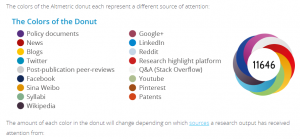Promoting research
Kate Harbison; Paula Callan; and Tanya Harden

These days it is important for researchers to be visible beyond academia. The old maxim of ‘publish or perish’ is transitioning to ‘be visible or vanish’. They need to promote themselves and their research. However, this is an area where many researchers may not feel comfortable. They may welcome information and training in expanding the reach of their research and maximising their impact.
This chapter will outline different tools and strategies researchers can use to promote themselves using social media, mainstream media and other methods.
Before you start make sure you are familiar with earlier chapters on Open Access and Author Profiles.
Getting started
Before starting it is a good idea to plan a research promotion strategy. There are many venues and tools available for a researcher to promote their research and it is important to choose a strategy that suits the researcher’s commitment, schedule and interests as well as their field. Investigate what platform their colleagues are using, ask the researcher what tools they use already and what they feel comfortable with or enjoy.
Official channels
Many organisations have their own marketing departments that put out press releases which can be used to promote a researcher and their work:
- Journals and Publishers
- Universities
- Societies and organisations
Networking tools
These provide a forum for researchers to connect and communicate with each other:
Be wary of ResearchGate and Academia.edu. Only one is needed (check the researcher’s field and colleagues) and their model is to request researchers upload their articles, which, in many cases, may be undesirable or illegal. The University of Oklahoma has a useful guide to them here.
Social media
Many researchers use social media to engage with their peers and the public. It takes time and energy to build a community on the platform of choice, so selecting the appropriate platform for the field is important. Usually the easiest way to do this is to see what colleagues are doing.
The most commonly used social media platforms for researchers are:
- Twitter
- Many researchers use Twitter as their main social media promotion tool. They should be prepared to post regularly and tag and retweet relevant partners and colleagues.
- YouTube
- Academic blogging
Mainstream media
Getting into the mainstream media is a great way to ensure research is noticed and publicised:
- Traditional media
- The Conversation
- Research from The Conversation is often picked up by other media too
- Expert guides
- Most universities have expert guides to steer the media towards the relevant researchers and marketing or media departments may offer training as well.

Explore: Check out these social media giants of the academic world: The thesis whisperer, Axel Bruns, Andy Miah, Gary Mortimer, or The A to Z of social media for academics from Times Higher Education.

 Exercise: You can use altmetrics to research what promotion strategies are used in different fields. Install the Altmetric Explorer bookmarklet (or you can use QUT ePrints). Navigate to a paper in your field and click on the Altmetric ‘donut’. This will give details of where the paper is being seen and discussed.
Exercise: You can use altmetrics to research what promotion strategies are used in different fields. Install the Altmetric Explorer bookmarklet (or you can use QUT ePrints). Navigate to a paper in your field and click on the Altmetric ‘donut’. This will give details of where the paper is being seen and discussed.Time to pick!
Each platform will have its own techniques and styles, but for every platform, it is important to write in easy-to-understand language. Use short clear sentences without technical terms or acronyms.
Some other tips include:
- Link directly to the research if possible
- Images make posts stand out
- Engage other users and colleagues by using hashtags and handles
- Respond to comments, thank people, retweet, repost
 Explore: There are lots of videos on Youtube about using Twitter or blogging. Even if you have tweeted before, take a few minutes to watch one or two – maybe Twitter for beginners 2021 or Twitter for academics : My tips
Explore: There are lots of videos on Youtube about using Twitter or blogging. Even if you have tweeted before, take a few minutes to watch one or two – maybe Twitter for beginners 2021 or Twitter for academics : My tipsLearn more

Plain language summaries are an excellent way to promote research, as they can engage an audience in the story of the research. Think about the audience and explain it so they understand. The writing should both tell a story and explain why the reader should care about the article. Keep it succinct (less than 500 words) and clear; use short, clear sentences and focus each paragraph on a single idea.
A plain language summary should answer the following questions:
- What is the research about
- What was done
- What were the results
- Why is it important, especially why it is important to the reader
Plain language summaries can give context to research and improve its discoverability. Researchers can often upload the plain language summary to their institutional repository. Additionally they could submit it to publications like The Conversation or trade journals, or use it for blog posts. Kudos is a digital research community that showcases research. Researchers can upload a plain-language summary, add an impact statement and link to other related resources such as images, videos or data.

Examples: Browse through Matt Brown’s publications on QUT ePrints here. He is a first class immunogenetics researcher with a particular interest in developing new treatments for ankylosing spondylitis. Now look at his article in The Conversation: Unexplained lower back pain? It could be ankylosing spondylitis. Which is easier to understand? Which do you want to read?

Now write a tweet for it – focus on the story, stick to the character limit, use hashtags and handles.
 Explore: Scholarcy is a website and browser extension which can assist with creating a summary of a publication and a tweet. Try it with the research paper from the exercise above and compare it to your versions. Or try this paper – The Experiences and Healthcare Needs of Families Living With Pediatric Brain Tumor: A Longitudinal Qualitative Study Protocol.
Explore: Scholarcy is a website and browser extension which can assist with creating a summary of a publication and a tweet. Try it with the research paper from the exercise above and compare it to your versions. Or try this paper – The Experiences and Healthcare Needs of Families Living With Pediatric Brain Tumor: A Longitudinal Qualitative Study Protocol.Challenge me

The mainstream media is a great way to broaden the reach and impact of research, to reach an audience beyond academia and the bubbles we move in. However, it ain’t easy! Here are some things to consider before you start preparing media releases.
Is it newsworthy?
This is the first question you need to ask. Journalists and networks are not interested in the beauty of the data or the academic significance of the results. They are interested in if the subject is newsworthy – will people read it or watch it.
Consider these five pillars of journalism:
- Timeliness – is it current and relevant to a particular debate or issue (e.g. Covid research)
- Proximity – is it something viewers will relate to because it is close to them (e.g. suburban town planning)
- Conflict/Controversy – these will attract attention (e.g. home schooling)
- Human interest – people are interested in people, does it tug on their emotions or beliefs (e.g. aged care)
- Relevance – does it have personal interest or will it help readers decide how to do things (e.g. screen time and children)
Significance is not about how significant the research is. It is about its impact or potential; how it will will enable, enrich, influence, inform or change the performance of policies, practices, products, services, culture, understanding, awareness or well-being of the community.
getting your message across

Whether pitching to a journalist, being interviewed, or even tweeting, the significance of the story is in the future!
Ask “what is the goal of the research, what is the ultimate benefit?” That is the start of the pitch. Do not assume the significance will be self-evident – articulate it! Explain it clearly, but do not dumb it down.
Explain it to your friends and family, make sure they understand! Do it again so it gets clearer and more concise. Look for the story in the research.
an easier way?
There are some other paths to getting research into the media.
Most institutions have marketing departments – make sure they know about this research and its significance. A media release from a university is more likely to attract attention than a pitch from a researcher or librarian. Expert guides from universities or research institutions are where journalists go to find someone to speak on a topic.
Just because research is not ‘newsworthy’, does not mean it is not suited for more targeted shows such as The Science Report, The Law Report, or subject specific podcasts. The Conversation publishes articles by academics and researchers that often get picked up by the mainstream media. Try pitching it to them first.

Check!
Which of these would make a good pitch for your research?
Attribution
Content in this chapter has been developed by QUT Library.
All information correct at time of publication, 16 November 2021.
ImaGE cREDITS
Royalty-free images used on this page were sourced from unsplash.com.
Icons created by priyanka and Wichai Wi from Noun Project.

